Baking Soda and Washing Soda sound similar but they are definitely not the same product. Both can be used to clean laundry, both can be used for household cleaning, but one can damage skin and the other can be eaten. Learn the difference between washing soda and baking soda PLUS find out their best cleaning uses.
Homemade Cleaner Ingredients
Ever tried making your own homemade cleaners? Some of the recipes are effective, some are so-so, and some are a total disaster. It’s a waste of time and ingredients when a new concoction doesn’t work as expected.
The #1 reason homemade cleaners fail? Choosing the wrong ingredients!
- Some natural cleaner recipes combine ingredients that neutralize one another or produce dangerous reaction.
- Other ineffective mixtures choose the wrong ingredients for the job.
It’s important to educated yourself about the ingredients you are using to be able to make the right choices and clean effectively. I like to know:
- How ingredients work.
- Where they are safe to use.
- What they should (and should not) be mixed with.
Green Cleaning Question
A lovely reader sent a message to my Facebook page asking why I include both baking soda and washing soda in some of my homemade cleaners. I started writing a reply and then realized I should share the answer with everyone.
What is Washing Soda?
Washing soda or soda ash are common names for Sodium Carbonate (Na2CO3). Washing soda is a caustic base (able to burn, destroy, or damage organic tissue slowly by chemical action). It is not edible, should not be inhaled, and can damage eyes (flush the exposed areas with large quantities of water). Gloves should always be worn when cleaning with washing soda.
What is Baking Soda?
Baking soda is the name commonly used for Sodium Bicarbonate (NaHCO3). Baking soda is a mild base that is commonly used as a leavening agent to raise baked goods. It is edible and is mild enough to be used as toothpaste or taken as an antacid. Baking soda is edible but should not be inhaled and can irritate eyes.
All-Natural Substances
Washing soda and baking soda are both natural substances made from a mineral called trona. Processing trona produces sodium carbonate and sodium bicarbonate. Both are white crystalline powders.
- Baking soda is a pure white powder with fine, dusty granules that cannot be felt.
- Baking soda granules are easy to dissolve in water and rinse clean
- It is a mildly abrasive cleaner that is good for scrubbing.
- Washing soda is a white-ish powder with larger granules that can be seen and felt.
- Washing soda granules dissolve slowly in water and will leave a white residue if not well rinsed.
- It makes a more abrasive cleaner that can scratch delicate surfaces but cleans well.
pH levels and Cleaning
We have to step back to high school chemistry class to continue examining the difference between baking soda and washing soda. Remember the pH scale?
The pH scale is used to determine if a liquid is acidic, basic, or neutral. The scale runs from 0 to 14, the center of the scale is neutral (number 7).
- Solutions from 0-6 on the scale are acidic.
- Solutions from 8-14 are basic.
- The further away from 7 you move on the scale, the more intense the acid or base.
- Substances at the ends of the scale are caustic (able to destroy organic materials/cause chemical burns). For example, battery acid has a pH of 0 and drain cleaner has a pH of 14.
- Each whole pH value is ten times more powerful than the next whole value. For example, pH 10 is ten times more alkaline than pH 9 and 100 times more alkaline than pH 8.
- When a base is added to an acid (or an acid added to a base), the solution moves toward the middle of the pH scale as it is partially or fully neutralized.
Using Bases to Clean Acids
Most of the substances that soil our homes and laundry are acidic when measured on the pH scale, so alkaline cleaners usually have the best results.
Washing Soda and Baking Soda are both alkaline (basic).
- Baking soda has a more neutral pH of 8.
- Washing soda is more alkaline with a pH of 11.
Different Bases, Different Uses
- The high alkalinity of washing soda helps remove grease and stains. It can also balance the pH level of water to enhance detergent’s effectiveness.
- Because washing soda is highly alkaline, too much washing soda can damage surfaces, fade colors, and eat away at fabric/surfaces over time.
- Mildly alkaline baking soda neutralizes odor causing acids, breaks down proteins and stains, and softens water to enhance detergent’s effectiveness.
- Because baking soda is a mild alkaline, it does not usually damage surfaces or fabrics but can take longer to clean.
- Household water has a pH range of 7 to 8.5. Optimal water pH for laundry is around 10.
- The pH of water can be raised with washing soda or baking soda. However, using too much washing soda can fade or weaken fabrics.
- Baking soda and washing soda should NEVER be mixed with acidic cleaning ingredients such as lemon juice or vinegar.
- The bubbling reaction when the ingredients are combined is the acid neutralizing the power of the alkaline cleaner.
- Alkaline cleaners need to attack acidic household soils to work well. Neutralizing their power with acidic cleaning ingredients makes them less ineffective.
When Baking Soda vs Washing Soda?
Both natural substances are effective water softeners, deodorizers, and alkaline cleaners. BUT because of the difference between washing soda and baking soda you should…
- Choose washing soda when cleaning:
- Sturdy surfaces or fabrics that are easy to rise (bathtub, shower door).
- The washing soda will clean without damaging the item and can be washed away easily.
- Choose baking soda when cleaning:
- Sturdy surfaces that are hard to rinse (oven floor or floor grout).
- Delicate surfaces that can be scratched (natural stone counters).
- Areas used by children and pets (carpet, pet beds).
- Food preparation surfaces (kitchen sink, cutting board).
- It has enough grit to clean but will not scratch surfaces, is easier to rinse clean, and it is edible so there is no residue worry.
- Choose both washing soda and baking soda when cleaning:
- Household stains and odors from items that can be easily rinsed but may be damaged by the overuse of a caustic substance (laundry).
- Using a combination of washing soda and baking soda raises the pH of water for optimal cleaning conditions while deodorizing and breaking down stains.
All-Natural Cleaning Recipes
Now that you’ve learned about washing soda and baking soda try using them to clean. Check out these all-natural cleaners that use baking soda and washing soda.
Cleaners that Use Baking Soda:
Cleaners that Use Washing Soda:
Cleaners that Use Baking Soda & Washing Soda:
- Borax Free Homemade Laundry Detergent
- Naturally Clean Smelly Towels
- Natural Homemade Dishwasher Powder
Like my green cleaning recipes and tutorials? Sign up for my free newsletter and never miss a thing.


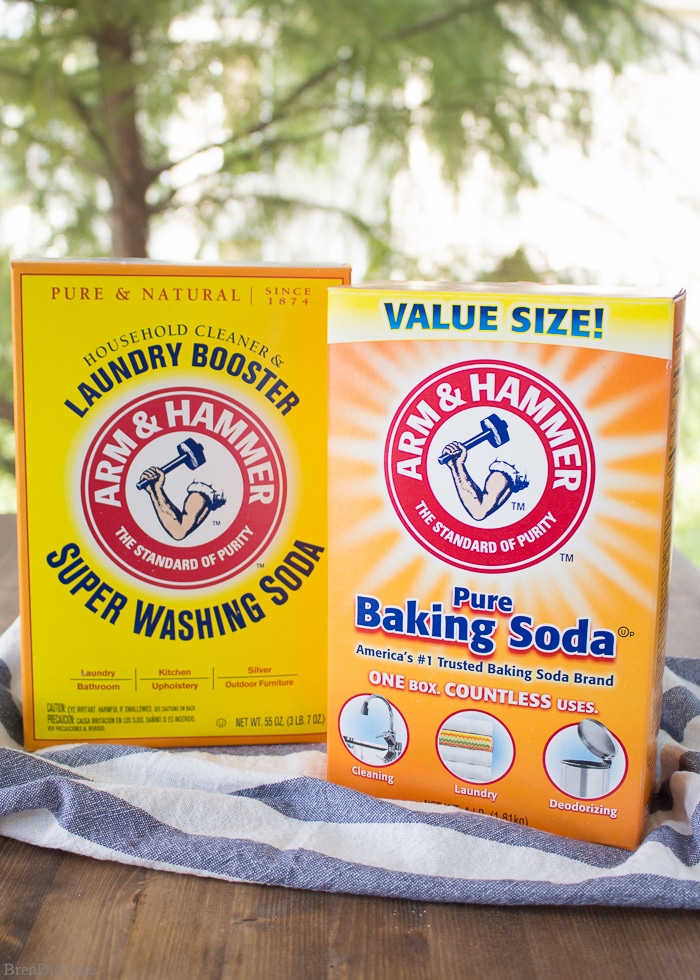
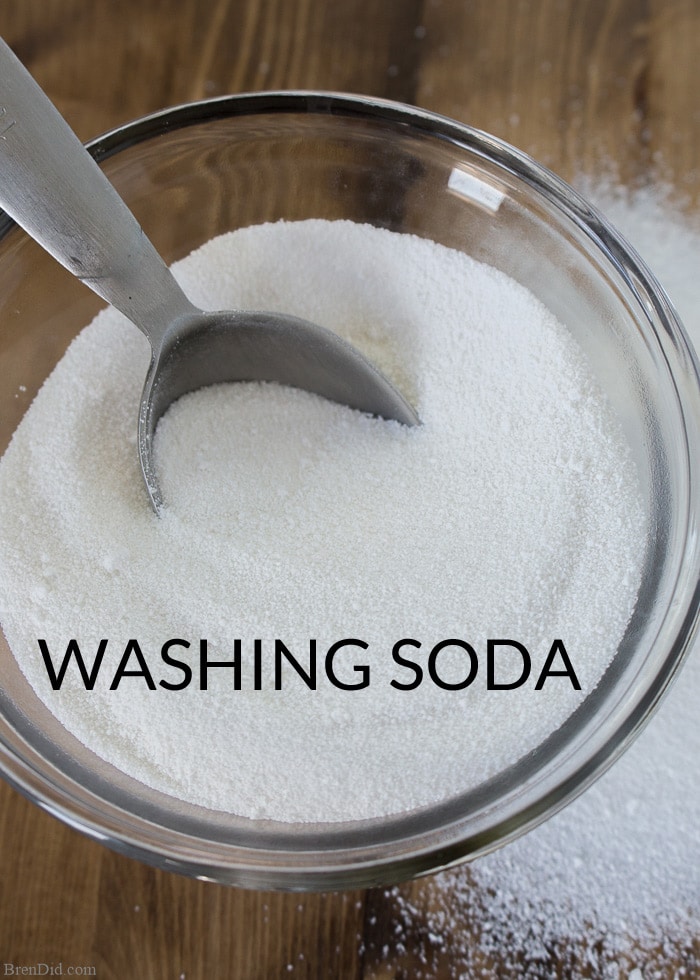
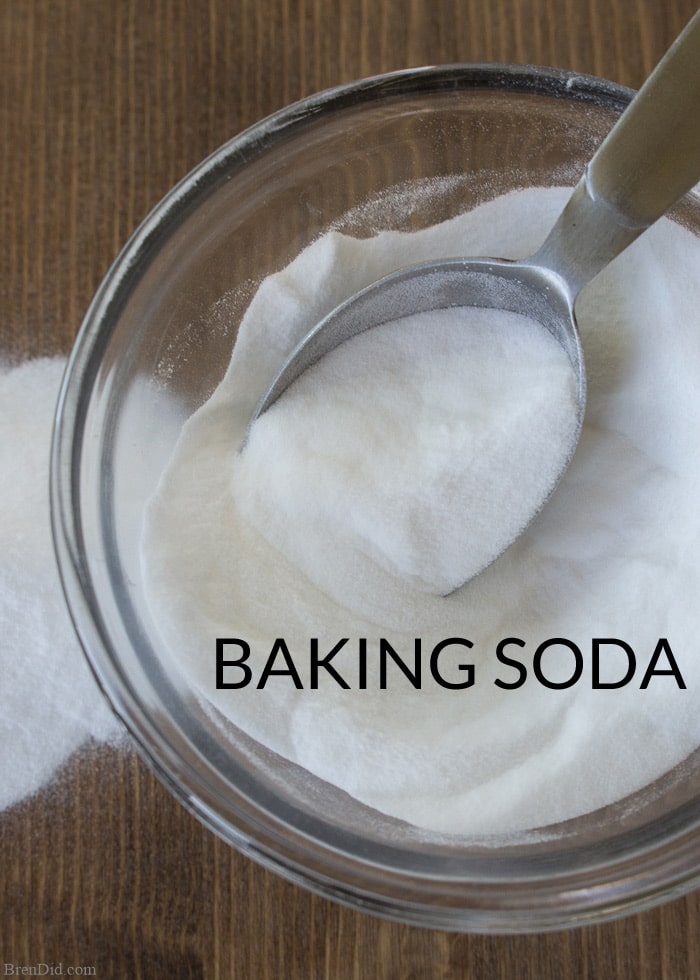
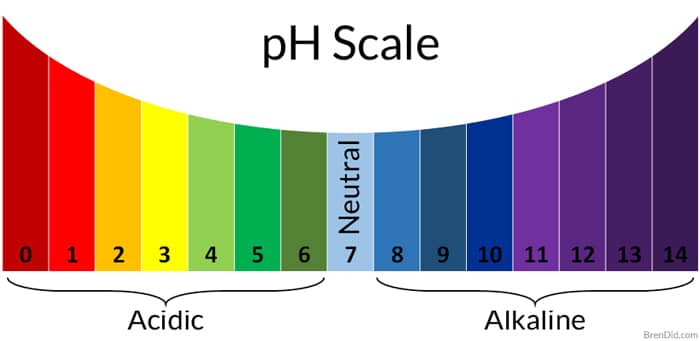
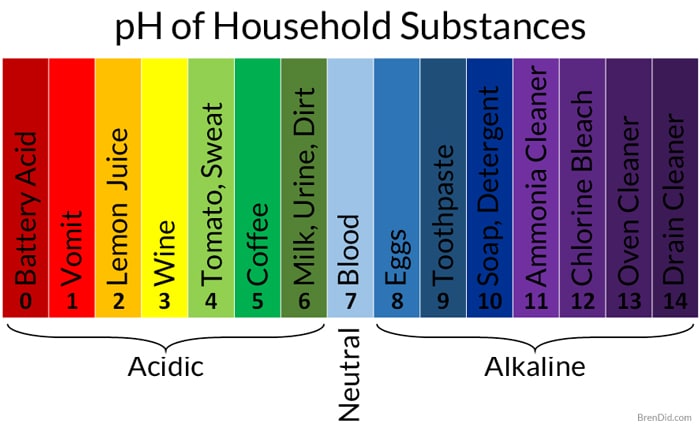

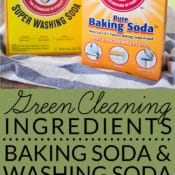
Natalie
Is there anything we can use in place of the oxiclean baby? I have to have it shipped but was looking for something to get in store.
Bren
You can substitute an equal amount of Oxiclean Free, 365 by Whole Foods Market Powder Oxygen Whitening or Ecos Oxo Brite.
Kate
If I want to wash my laundry and make my own washing powder, should I use bakong or washing soda? I want to combine this with greated Aleppo soap. Thank you.
Bren
Kate, I use both in my powdered detergent recipe and my liquid detergent recipe that contains castile soap. You
annie
Hi
Can you tell us which one can damage the skin ?
Bren
Washing soda (Sodium Carbonate, Na2CO3) can damage the skin.
Wendy
Hi Bren, Sandra also mentions trying to return her now cream colored whites back to their original white whites. I think I read that OTC fabric softener products created this problem. Will a vinegar rinse, used at the right time, after washing with your soap recipe return these fabrics to their former white, or is the damage done… like a permanent stain? Have you any experience with this?
Bren
Whites can be permanently discolored to a yellowish color if they are overbleached, most other discolored whites can be restored by soaking in washing soda or oxygen bleach and then washing normally. A vinegar rinse is great for helping the detergent rinse clean. I use vinegar on most of my laundry (not delicates or stretch exercise clothes).
Stef
In which ratio should baking and washing soda be used then to come close to the optimum ph of 10 for laundry? Such an interesting article!
Bren
The effect of the baking soda and/or washing soda will be influenced by the current pH of your water and the amount of water in your washing machine. It can take anywhere from 1/4 – 1/2 of a cup of washing soda to raise the pH. Try adding a bit to your laundry and see how you like the results!
Charles
does washing soda damage copper plumbing?
Bren
Charles, This Old House recommends baking soda for cleaning copper.
Richelle
I’ve been using arm and hammer washing soda with my husband’s work clothes laundry as an additive to help get out the dirt stains and odors. Would you think just regular baking soda would be just as effective because the washing soda does seem to help and it does seem to soften them some. Thanks in advance for your advice.
Bren
I would try a comparison load and see which you like better. The baking soda will be more gentle on the fabric but you might miss the extra cleaning power.
Andrea Schorr
What would you recommend to super soften flannel shirts, medium weight denim shirts and medium weight flax pants?
Bren
I would add half of a cup of baking soda to each wash load.
Susan
Where can I buy a several ounces of washing soda cheaply and easily? Needed for washing a special fabric item.
Bren
Susan, washing soda is sold in the laundry aisle at more us grocery stores!
Mathews M. J.
Truly beneficial, Thank you.
Adriana
Thank you very much for this post. It was direct and very informative. I am already writing down the recipes that you recommended at the end!
Maria
Hi, someone suggested I use washing Soda on my feet which have onychomycosis. However I’m worried it’ll cause more problems and I have a couple of cuts on my feet.
Bren
It’s NOT safe to apply sodium hydroxide (washing soda) to your skin. Sodium hydroxide can cause chemical burns, hives or rash. I would NOT apply it to your feet. Baking soda can be used as a foot soak.
Tommy
There is a hair washing method I stumbled upon on the internet called “No-poo” (meaning no shampoo) including the use of baking soda diluted with water (and rinsing) and later on, applying diluted vinegar (and rinsing). Do you think would it be safe to use washing soda even more diluted with more water instead of baking soda in such a procedure?
Bren
No, you should not use washing soda on human skin or hair.
Neleh
For a slow-running bathtub drain, what do you recommend? I’m in a mobile park home, renting a room and bath. My tub drain is draining VERY slow, my housemate’s isn’t. She’s in the master bath, I am not. I don’t want to risk causing her drain problems.
Bren
I would check for hair in the drain (You’ll have to search how to remove the drain stopper) then use straight vinegar to dissolve any soap residue.
Tricia
So…the only question I have remaining is whether it’s okay or not to use JUST baking soda in a DIY laundry detergent, or will it not clean well enough?
Bren
It depends on the other ingredients. I have several detergent recipes (liquid and powdered) plus a Q&A that might help.
CHANDRA
Thank you bren. I learned lot from your article. I need to soak and clean vegetable juicer parts. What would you recommend?
Cheers
Chandra from Melbourne
Bren
Detergent and water with a vinegar rinse. This DIY scrub also helps.
Patricia Morrish
I mixed washing soda with hot water and dissolved it well and then added some liquid castile soap. It clumped up a bit and looked a little waxy. Too much castile or too much washing soda? Do you have a recommended ratio?
Bren
Are you making detergent? You can find my measurements for liquid laundry detergent here and dish-washing detergent here. Both recipes can be made with castile and washing soda. Good luck!
Phuan SE
Can we sprinkle & dissolve washing soda in water to doak vegetables & fruits to remove any pesticides
Bren
No, baking soda can be used to clean fruit and vegetables. Washing soda cannot be used on edible items.
Mary frances
is ot true you can make baking soda by oven cooking washing soda?
i read that but it doesn’t make sense to me; particularly as i am told one is edible and the other isn’t
Bren
I’ve never tried to make it at home in the oven. There is no accurate way to test the substance at home to see which you have produced.
Charlotte Dirk
Actually, it is the other way. Cooking baking soda yields washing soda. It is not an efficient process, and as Bren said it is difficult to test. If the reaction is complete, and there is no loss from spillage expect a 37% loss in weight, because water and carbon dioxide are driven off. If the sample is damp, or the temperature not right, or you cook it too long, you will have a greater weight loss (more than 50%) and end up with lye. If you want washing soda, buy washing soda! If you want baking soda, buy baking soda!
Bren
Thanks for the input, Charlotte!
Ani
Hi Bren,
Thanks so much for the post! I’ll be trying out the detergent recipe soon!
I have one question: we have a used baby bassinet and I cannot take it fully apart, is there a way to spot clean it so that it removes dirt (without submerging in water) but also doesn’t damage the product?
Thanks!
Bren
Ani, are you cleaning fabric or the basket part? If fabric I would use this tutorial from my friend Ananda. If cleaning the basket part I would spray lightly with a mixture of 1 cup water to ½ cup vodka and allow to dry. Hope this helps!
Kotha Gopal
Baking soda and bleaching powder are same or not
Bren
No, they are not the same.
Frank
Both are included in DIY laundry recipes as water softeners, precipitating calcium, magnesium, iron, and manganese ions as carbonates, thereby eliminating them from competition with soap molecules, which are fatty acids. Salts if fatty acids and those ions form what is commonly referred to as scum. Unfortunately, no mention is made of this important reason for their use.
Bren
Thanks for commenting, Frank. This is a good reason for their use. I also like to fight soap scum in homemade detergent with a vinegar rinse.
Frank
What is the best way to remove soda ash from clothes? Is there something we can add to the washing machine to lift soda ash off the clothes?
It’s irritating my daughter’s skin so we need to remove any sign of soda ash in her clothes.
Thank you for the article!
Bren
Use a vinegar rinse. Vinegar contains is acetic acid that breaks down the washing soda. I use vinegar in my fabric softener compartment. Good luck!
Frank
Thank you for your reply Bren! Didn’t get a notification of your reply but checked back on the site and found it. Have already started to use vinegar in the rinse. Thanks again!
Judi
Thank you sooo much for breaking it down when explaining the acidity versus alkalinity. Can now understand what to use where.
Bren
You’re welcome, Judi!
Bonnie Kropoff
I cleaned up a washing soda spill without gloves 4 days ago and still have it on my hands through several hand washings. Can you tell me how to remove it? Thanks.
Bren
I would wash with white vinegar and then mild soap then apply lotion. You may have a mild chemical burn.
Christine
In the article it states never to mix lemon juice or vinegar with baking soda & washing soda because it will neutralize but in your dishwasher recipe it calls for citric acid. Wouldn’t citric acid cause neutralization too?
Bren
There would definitely be some neutralization, Christine. Have you seen my lemon dishwasher detergent? It doesn’t have that issue.
peg and kev
Much obliged for your concise and informative ingredient recipes and cleaners, as we have had a disagreement over these differences for years and you saved THE DAY. More like it, and many many thanks. BEST yet….M. and K. Dwyer
Bren
Thanks! 😉
Barb
Good info here. I do have a slightly different question. Can a combination of baking powder ( currently don’t have b. soda) and vinegar work for deodorising/sanitising a front loading washing machine?
Bren
Baking powder is a dry mix made of an acid (calcium acid phosphate, sodium aluminum sulfate or cream of tartar) and a base (sodium bicarbonate – AKA baking soda) that reacts to form CO2 bubbles in batter when a liquid is added. It is specifically formulated for baking and would probably not help much in cleaning. To clean/deodorize a front loading washer you can use plain white vinegar. I run an empty “cleaning cycle” load in my washer with white vinegar in all the compartments then wipe down all the seals with a cloth soaked in white vinegar. Finally I leave the washer open to dry and make sure all the seals are well dried. White vinegar is a great deodorizer.
Deanna L Herald
On another page, you mention not mixing soda and acid, because they neutralize each other. Why did this recipe mix the two?
Bren
Sorry Deanna, I don’t understand the question as it applies to this post.
july
Thanks…It helped me lot…Bren Mam!:)
Bren
😉
july
Thanks! It helped me lot…
Kara
What about using vinegar as a pre-treatment for armpit stain/smells? My shirts still smell in the pit area even after washing. I’ve been wanting to spray it with a vinegar solution, let it soak for a bit and then wash. Will the vinegar still react with the natural detergent that has baking soda and washing soda in it? Should I use a baking soda paste to remove the smell instead?
Bren
You should not be introducing enough vinegar by spritzing the underarms to counteract the natural detergent. However, you can use a paste with baking soda such as this stain treater that will remove the smell if you can concerned and use the vinegar rinse as fabric softener. It deodorizes as it softens and helps remove detergent residue. Hope this helps! Bren
Rachel
You mentioned to never mix baking soda/washing soda with vinegar. Would you still be able to use your laundry soap recipe with a vinegar ‘fabric softener’? Or would you suggest some other method for softening clothes?
Bren
It works great in the laundry as a fabric softener because it is not added until you want to soap to rinse out / break down. You can read more in my fabric softener or laundry detergent posts.
Charles
What is the difference between baking soda packaged specifically for cleaning and deodorizing, with a warning not to use it as an antacid, and edible baking soda that can be used as antacid.
bobbyjoe thomas
Thank you. This is EXACTLY the information I was looking for.
Bren
Thanks, Bobbyjoe! Glad it was helpful.
Karen
Finally the first blog that talks about baking soda and washing soda and doesn’t suggest to be cheaper you bake it in the oven. This a very good post. My other pet peeve is when the bloggers tell us to mix Dr Bronners with vinegar the web site says don’t do it but people don’t go to thee web site. Another pet peeve is when bloggers use hydrogen peroxide with a clear bottle. Thank you for doing due diligence.
Bren
Thanks Karen! I do love to save money, but don’t think there is enough of a cost difference to make my own washing soda. I agree, no mixing Castile soap with vinegar! You should check out my post Green Cleaning Ingredients You Should Never Mix.
Sandra M
Just started questioning clothes washing techniques after seeing an article on how to whiten my ” no longer white, but creamy towels “. The hack recipe failed, but led me on a journey to learn how they got in that state to begin with. Seemingly, Laundry softener was the biggest contributor. As a good mother & spouse, I would never have contemplated washing clothes WITHOUT a good fabric softener !
Older with much more time to think, am now researching better, healthier options for everything.
Am still confused with ALL the information out there, though very much enjoying your reader’s queries and your responses. Reading, reading, and re-reading; I am determined to understand as now the concern extends to grandchildren, and great grandchildren, teaching them the correct ways, not the easy ways.
I came across a recipe to get .clothes cleaner and fresh smelling without resorting to fabric softeners, oxiclean and the like. Learned a great deal from your blog, yet still eliciting more questions. The whites still not coming out A+, and don’t want to resort to more toxic chemicals such as Clorox. Laundry smells good fresh and clean.
My go to Laundry cleaner is now – 1 cup washing soda 1 cup white vinegar with lesser liquid detergent than I was in the habit of, all thrown in together at beginning of wash.
However. I learned today, from your post, that I am negating the effect of the washing soda by adding the vinegar! What am I doing wrong?
Bren
You are definitely on the right path! I would use the washing soda and detergent in the wash and add the vinegar to the rinse water. I pour white vinegar right into my fabric softener compartment since I do not use commercial fabric softeners. The vinegar will help rinse out the detergent and soften the laundry.